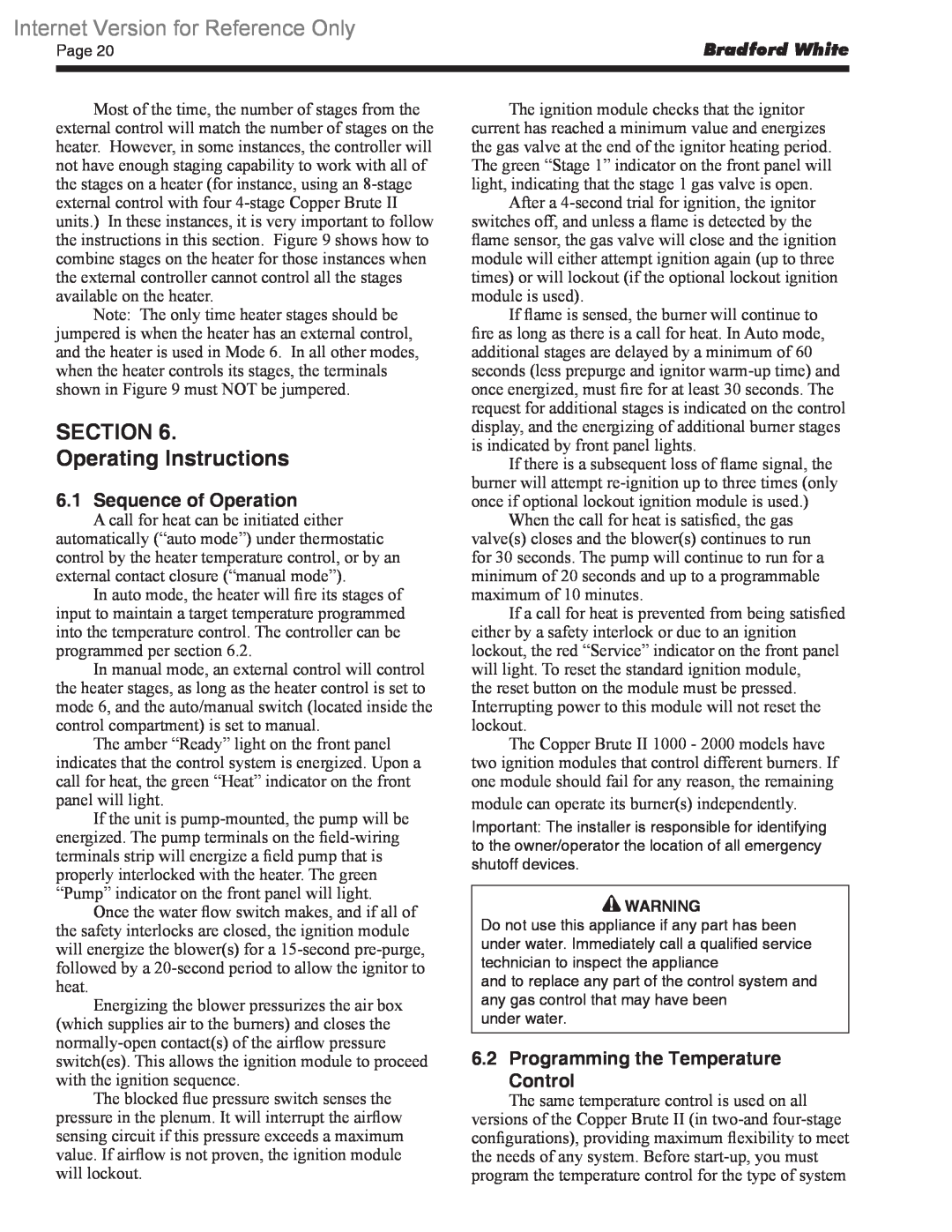
Internet Version for Reference Only
Page 20 | Bradford White |
|
|
|
|
Most of the time, the number of stages from the external control will match the number of stages on the heater. However, in some instances, the controller will not have enough staging capability to work with all of the stages on a heater (for instance, using an
Note: The only time heater stages should be jumpered is when the heater has an external control, and the heater is used in Mode 6. In all other modes, when the heater controls its stages, the terminals shown in Figure 9 must NOT be jumpered.
SECTION 6.
Operating Instructions
6.1Sequence of Operation
A call for heat can be initiated either
automatically (“auto mode”) under thermostatic control by the heater temperature control, or by an external contact closure (“manual mode”).
In auto mode, the heater will fire its stages of input to maintain a target temperature programmed into the temperature control. The controller can be programmed per section 6.2.
In manual mode, an external control will control the heater stages, as long as the heater control is set to mode 6, and the auto/manual switch (located inside the control compartment) is set to manual.
The amber “Ready” light on the front panel indicates that the control system is energized. Upon a call for heat, the green “Heat” indicator on the front panel will light.
If the unit is
Once the water flow switch makes, and if all of the safety interlocks are closed, the ignition module will energize the blower(s) for a
Energizing the blower pressurizes the air box (which supplies air to the burners) and closes the
The blocked flue pressure switch senses the pressure in the plenum. It will interrupt the airflow sensing circuit if this pressure exceeds a maximum value. If airflow is not proven, the ignition module will lockout.
The ignition module checks that the ignitor current has reached a minimum value and energizes the gas valve at the end of the ignitor heating period. The green “Stage 1” indicator on the front panel will light, indicating that the stage 1 gas valve is open.
After a
If flame is sensed, the burner will continue to fire as long as there is a call for heat. In Auto mode, additional stages are delayed by a minimum of 60 seconds (less prepurge and ignitor
If there is a subsequent loss of flame signal, the burner will attempt
When the call for heat is satisfied, the gas valve(s) closes and the blower(s) continues to run for 30 seconds. The pump will continue to run for a minimum of 20 seconds and up to a programmable maximum of 10 minutes.
If a call for heat is prevented from being satisfied either by a safety interlock or due to an ignition lockout, the red “Service” indicator on the front panel will light. To reset the standard ignition module,
the reset button on the module must be pressed. Interrupting power to this module will not reset the lockout.
The Copper Brute II 1000 - 2000 models have two ignition modules that control different burners. If one module should fail for any reason, the remaining
module can operate its burner(s) independently.
Important: The installer is responsible for identifying to the owner/operator the location of all emergency shutoff devices.
![]() WARNING
WARNING
Do not use this appliance if any part has been under water. Immediately call a qualified service technician to inspect the appliance
and to replace any part of the control system and any gas control that may have been
under water.
6.2 Programming the Temperature Control
The same temperature control is used on all versions of the Copper Brute II (in
